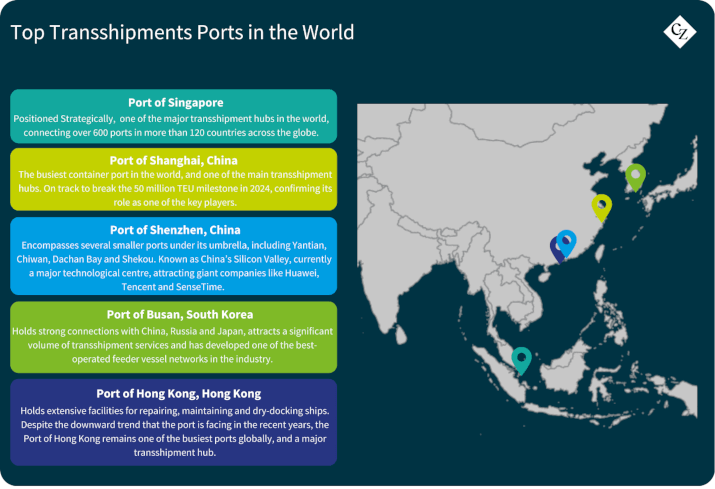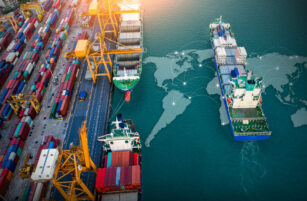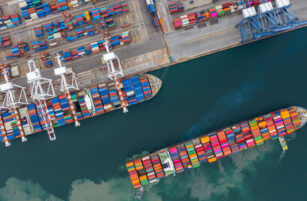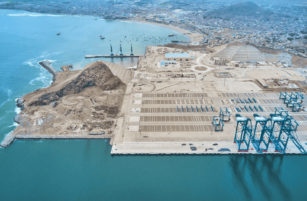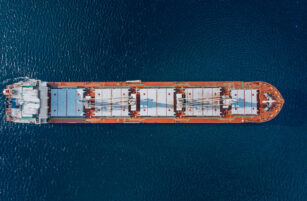Insight Focus
Transshipment simplifies complex shipping routes. Not only does it offer cost-effective alternatives to direct shipping, but it also allows companies to navigate restrictions and optimise resources. Asia dominates in global transshipment hubs due to its strategic location and infrastructure.
Shipping terminology can be complex, often leading to confusion even among industry professionals. One of the most commonly misunderstood terms is “transshipment.”
This article clarifies the meaning of transshipment, highlights the differences between transshipment and direct shipment, explains how it differs from transloading, and identifies the world’s top transshipment ports.
Understanding Transshipment
Transshipment refers to the process of transferring cargo from one vessel to another at an intermediate port before it reaches its final destination. This method is often employed due to factors such as the lack of direct shipping routes, legal restrictions or cost considerations.
During transshipment, containers are initially loaded onto a vessel at the port of origin, transported to a transshipment hub, unloaded and then reloaded onto a different vessel for delivery to the final port.
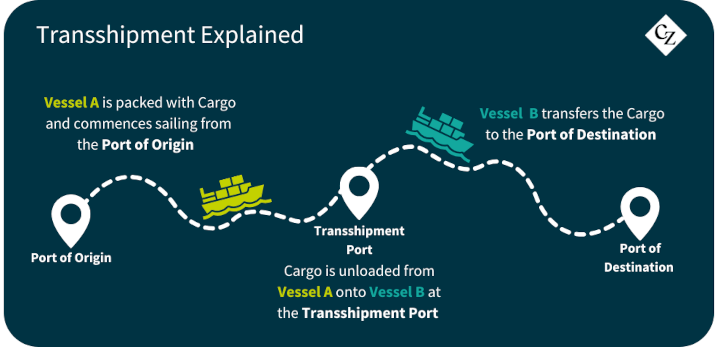
In a simpler way, transshipment describes the process of moving cargo from point A to point B via point C. Point C is the transshipment hub, where the cargo is unloaded and reloaded onto a different vessel.
An example of a transshipment route could be a cargo transportation from the port of Marseille in France to the port of New York in the US via the port of Valencia in Spain.
In this scenario, the cargo is packed into a container and loaded onto a vessel (Vessel A) that commences its sailing from Marseille to Valencia. Once the container arrives in the Spanish port, it is unloaded from Vessel A and reloaded onto another vessel (Vessel B). Vessel B, then, transfers the container from the port of Valencia to the port of New York. Once the container reaches the US port and is unloaded, the transshipment process is complete.
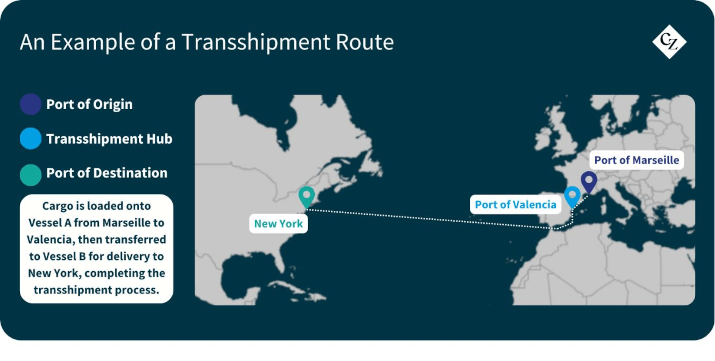
In this example, the port of Marseille is the Port of Origin, the Port of Valencia serves as the Transshipment Port and the port of New York is the Port of Destination.
Causes Leading to Transshipment Options
There are several reasons that drive shippers and carriers to consider transshipment options:
- Lack of direct connection between ports: One of the most important reasons is the lack of a direct route between the port of origin and the port of destination. When there is no direct connection between Point A and Point B, cargo must be transported via a transshipment port (Point C), where the following direct routes exist: Point A à Point C and Point Cà Point B.
- Large Vessel Limitations: The handling capabilities of the ports play a crucial role in the cargo transportation process. If the port of destination cannot accommodate large vessels, but the cargo has been loaded onto such a vessel at the port of origin, the containers need to be transferred to a smaller vessel at an intermediate hub to reach their final destination.“Deconsolidating larger shipments into smaller vessels and vice versa, smaller shipments can be consolidated into larger vessels, achieving economies of scales,” noted the largest container shipping company MSC.
- Cost Savings: Although transshipment options may require additional days for cargo to reach its destination, they often represent considerably less expensive alternatives with lower transportation costs for freight forwarders.
- Political or Legal Restrictions: Transshipment options can help avoid restrictions on shipments between two countries or certain types of cargo. By using an intermediate port in another country, these restrictions can be circumvented.
- Intermodal transportation: A term describing the transportation of cargo combining two or more different modes of transportation. For example, a container might be transported by sea from Point A to Point C and then by road from Point C to Point B. Any intermodal transportation is considered transshipment, as it involves an intermediate stop.
Differences Between Transshipment and Direct Shipment
Here are the key distinctions between transshipment and direct shipment:
- Routing: In direct shipment, cargo travels directly from origin to destination on a single vessel, while transshipment includes an intermediate stop for cargo transfer to another vessel.
- Number of Ports: Direct shipments use two ports (origin and destination), while transshipment involves three (origin, transshipment hub, and destination).
- Vessels Used: Direct shipments utilise one vessel for the entire journey, whereas transshipment requires two vessels throughout the process.
- Cost: Direct shipments are generally more expensive than transshipment options.
- Speed: Direct shipments tend to be faster, while transshipment can introduce additional delays.
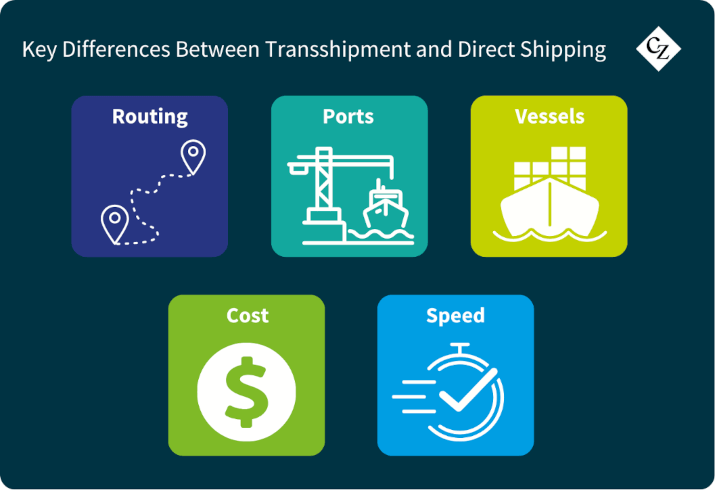
Transshipment vs. Transloading
While transshipment and transloading are related concepts, they serve different purposes. Transloading involves transferring cargo from one container to another—typically of a different type—whereas transshipment pertains to moving cargo from one vessel to another while keeping it in the same container. Transloading may be employed to reduce transportation costs, switching modes of transport.
The Importance of Transshipment
Transshipment is not merely a logistical nuance; it is a strategic solution to various challenges faced in the shipping industry. It allows for the efficient movement of goods between ports, enabling shippers to navigate obstacles such as the lack of direct shipping routes, legal restrictions and cost considerations.
In fact, many major global port operators are increasingly interested in acquiring/operating specific ports and terminals, considering their transshipment potential.
A prime example is COSCO SHIPPING Ports’ acquisition of the Port of Piraeus in 2016. Despite Greece’s lacklustre performance in the imports and exports sector, the Chinese shipping conglomerate recognized Piraeus potential in the transshipment market.
Through significant investments and development, COSCO transformed Piraeus into one of the most important ports in the Mediterranean and Europe, showcasing the strategic value of transshipment hubs in global trade.
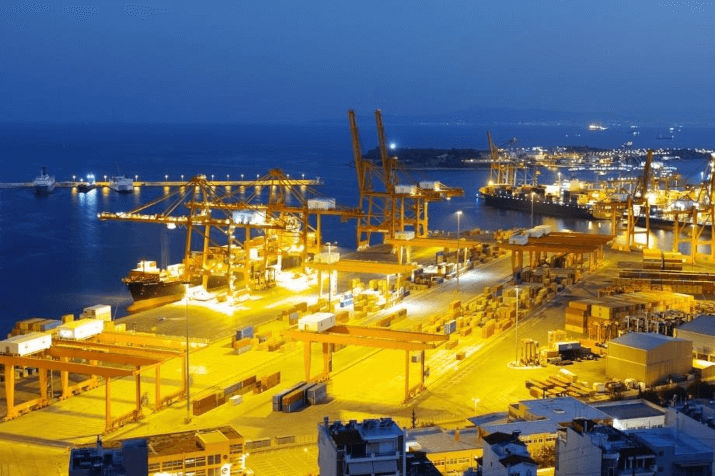
Port of Piraeus Container Terminal (2018)
Top Transshipment Ports in the World
It’s interesting to explore the world’s major transshipment ports, which handle the largest container volumes globally. The top hubs are situated in Asia, largely due to the region’s strategic location along major shipping routes and its advanced port infrastructure.
